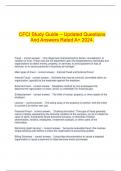CFCI Study Guide – Updated Questions
And Answers Rated A+ 2024.
Fraud - correct answer. "Any illegal acts characterized by deceit, concealment, or
violation of trust. These acts are not dependent upon the perpetrated by individuals and
organizations to obtain money, property, or services; to avoid payment or loss of
services; or to secure personal or business ad-vantage."
Main types of fraud - correct answer. Internal Fraud and External Fraud
Internal Fraud - correct answer. Activities that may be criminal, committed within an
organization, typically by the employee against the employer.
External Fraud - correct answer. Deceptive conduct by non-employees that
deprives the organization of value, and/or is undertaken for financial gain.
Embezzlement - correct answer. The theft of money, property, or other assets of the
employer.
Larceny - correct answer. The taking away of the property of another, with the intent
to convert it to his/her own use.
Financial Fraud - correct answer. "Cooking the books." This type of fraud generally
refers to falsely representing the financial condition of the company, so as to inflate the
value of stock, fraudulently boost executive bonuses, or otherwise mislead
shareholders, lenders, employees, investment analysts, or other users of the
information.
Skimming (cash larceny) - correct answer. Accounts receivable fraud, this involves
simply stealing cash before it enters the organization's accounting system.
Billing Schemes - correct answer. Using false documentation to cause a targeted
organization to issue a payment for false services and/or purchases.
,Check Tampering - correct answer. Common method (Taking advantage of employee
access to blank company checks, using a password to
steal computer-generated checks or producing counterfeit checks).
Employee reimbursement scheme - correct answer. Making false claims for
reimbursement or inflating or creating fictitious business expenses. (Travel /meal
reimbursement.
Corruption - correct answer. Bribery, illegal gratuities, and/or extortion.
Bribery - correct answer. When something of value is offered or given to influence a
business decision.
Illegal Gratuities - correct answer. When something of value is given to an employee
to reward a business decision.
Extortion - correct answer. When a person demands payment or seeks to influence a
business decision by threat of harm through loss of business or personal injury.
Kickback Schemes - correct answer. Forms of corruption involving employees and
vendors, often using inflated billing or invoices for which the employee is paid a portion
of the inflated or fictitious invoice.
Credit Card Fraud - correct answer. The creation, sale, or use of a counterfeit credit
card, or the use of a stolen credit or debit card.
C.N.P - correct answer. Card not present transactions
Identity Theft - correct answer. The fraudulent acquisition or stealing of confidential
personal information through social engineering.
Identity Fraud - correct answer. Involves the unauthorized use of another person's
personal data for illegal financial benefit. Involves abusing the stolen information to
transact personal business in the victim's name.
Wildcat Banking - correct answer. An extreme form of what was called free banking.
"A bank that issued notes without adequate security in the period before the
establishment of the national banking system in 1864".
2 categories that encompass Fraud - correct answer. Theft (stealing money, ID, or
assets) and deception (cooking the books, lying to shareholders, employees or
partners)
Savings and Loan Crisis - correct answer. The failure of about 1000 savings and loan
banks as a result of risky business practices. The roots of the S&L crisis lay in
, excessive lending, speculation, and risk-taking driven by the moral hazard created by
deregulation and taxpayer bailout guarantees.
Myth #1 of the Financial Services - correct answer. "We have very little fraud here" ex:
subprime mortgage fraud
Myth #2 of Financial Services - correct answer. "Ethics and training compliance has
us covered" Fraud is not always covered in ethics policy or training.
Myth #3 of Financial Services - correct answer. "Fraud is an unavoidable cost of doing
business" Fraud is usually not serious enough to destroy a financial service firm, it is
much more than necessary cost of doing business.
Chapter 1 review points - correct answer. • Statistical picture of fraud. The numbers
do not lie: Fraud is a huge worldwide problem—for all organizations.
• Financial services fraud. Seventy-four percent of financial institutions experienced
attempted payment fraud (check fraud, ACH fraud, or credit card fraud in 2020).
• Definitions of fraud. The broad definition of fraud is illegal activity representing either
theft or deception, or a combination of both.
• Myths about fraud. It is easy to become complacent about fraud but doing so can be
very costly. Fraud does occur in every organization and is potentially serious enough to
cause major long-term damage.
• Main types of fraud. Countless varieties of fraud threaten financial institutions.
Fraudsters are constantly thinking up new ways to target financial services institutions.
20-60-20 rule of human component of fraud - correct answer. 20% of people will never
commit fraud
60% are fence sitters and may commit fraud if given the opportunity
20% of people are inherently dishonest
2 types of insider fraud threat - correct answer. Employee level fraud and
management level fraud
True or False: Managment Level Fraud is committed less frequently than employee
level fraud? - correct answer. True: Management level fraud is committed less
frequently than employee level fraud however the financial loss is almost always
greater.
Fraud Triangle - correct answer. Created by leading criminologist Donald Cressey.
The three factors that contribute to fraudulent activity by employees: opportunity,
financial pressure, and rationalization.
Financial pressure - correct answer. Financial difficulties, such as large amounts of
credit card debt, an overwhelming burden of unpaid medical bills, large gambling debts,
extended unemployment, or similar financial difficulties.




